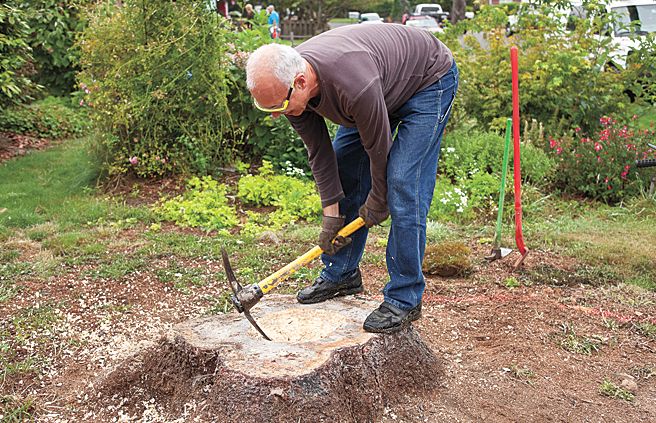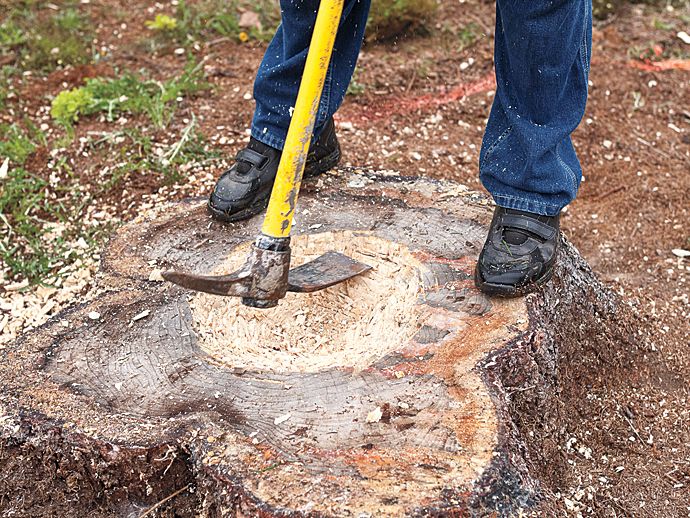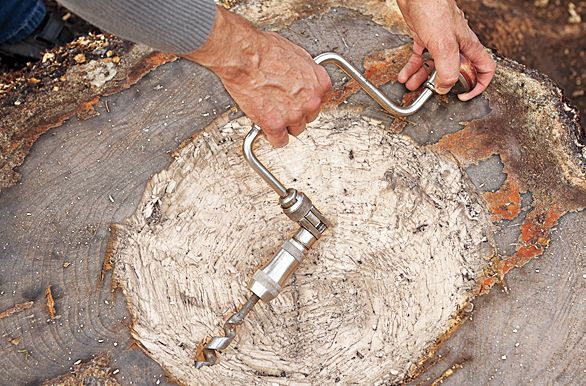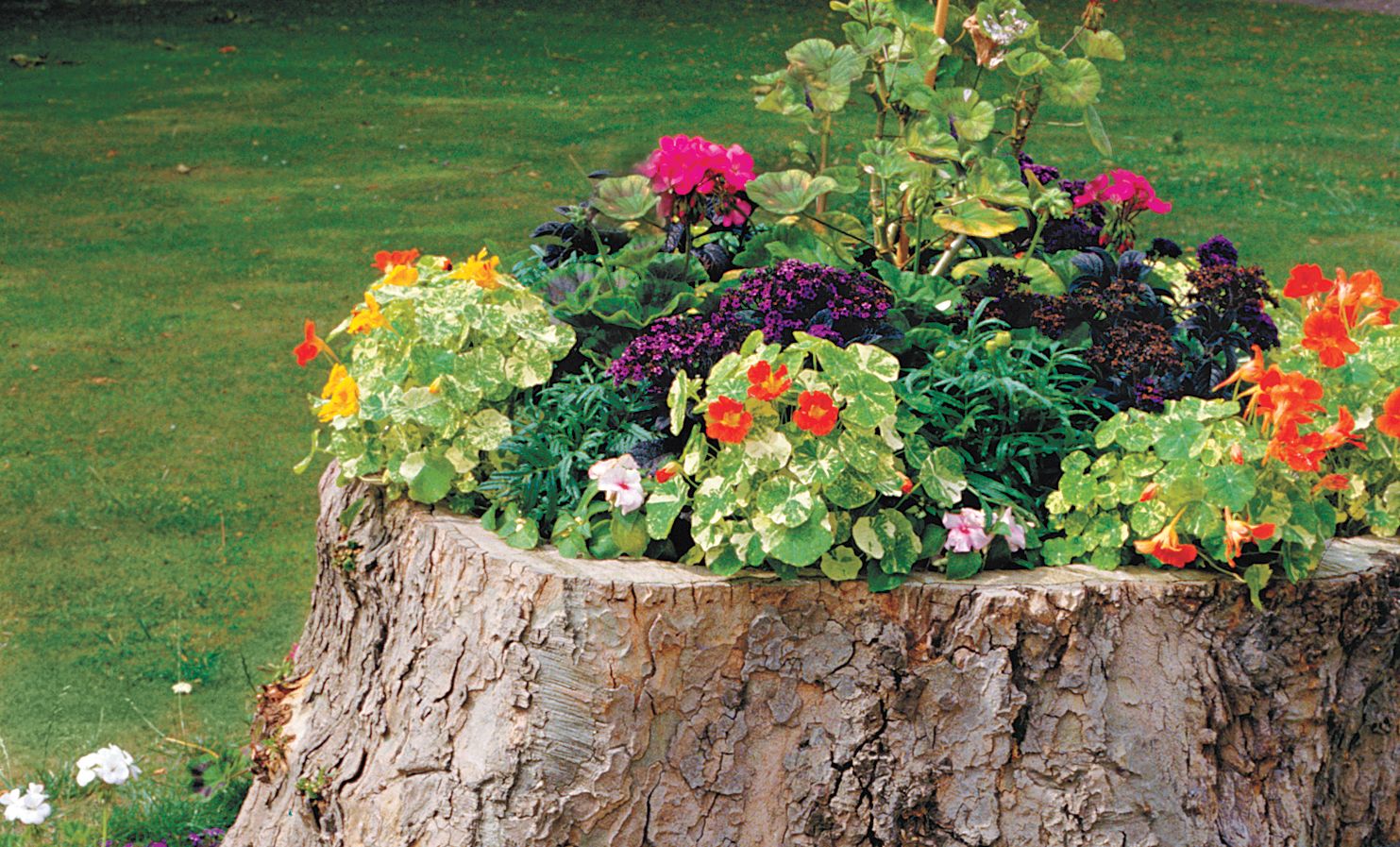We may be compensated if you purchase through links on our website. Our team is committed to delivering honest, objective, and independent reviews on home products and services.
Transforming a tree stump into a vibrant planter is an innovative way to repurpose what might otherwise be considered landscape waste. This creative project saves you the expense of stump removal and adds a unique, eye-catching feature to your garden. With some basic tools and a bit of effort, you can turn that old stump into a thriving flower bed.
Tools and Materials
Before you begin your tree-stump planter project, gather these necessary tools and materials:
- Mattock
- Safety glasses
- Auger or power drill
- Auger bits (3/8- to 1/2-inch)
- Garden trowel
- Work gloves
- Shovel
- Hammer and chisel (optional)
- Potting soil
- Compost
- Gravel or small rocks
- Plants or seeds of your choice
Having all the necessary tools and materials before starting will make the process smoother and more enjoyable.
Step-By-Step Guide To Creating a Tree-Stump Planter
With some basic tools and effort, you can transform your landscape and give new life to an old stump.
Step 1: Start the Planting Hole

Begin by wearing safety glasses to protect your eyes from flying wood chips. Take your sharpened mattock and use the pointed end to chip away at the center of the stump. This initial step is important for creating the foundation of your planter.
As you work, maintain a consistent depth across the stump’s center. The goal is to create a bowl-like depression that will eventually hold your soil and plants. Take your time with this step, as rushing could result in an uneven surface or damage to the outer edges of the stump.
The proper initial depth is key to a solid foundation. Taking the time to create an evenly carved-out center will make subsequent steps more manageable.
Step 2: Finish the Planting Hole

As the hole becomes larger, switch to using the wider end of the mattock. This will help you remove more material efficiently. Continue working toward the edges of the stump, but be careful to leave at least a 3-inch border around the perimeter. This border will serve as the “walls” of your planter and help retain soil and moisture.
Aim to create a hole that is between 4 to 8 inches deep. The depth you choose will depend on the overall size of your stump and the types of plants you intend to grow. Deeper holes are better for plants with longer root systems, while shallower ones work well for succulents and other shallow-rooted plants.
Remember, a well-carved planting hole enhances stability and aesthetics, providing robust and appealing housing for your plants.
Step 3: Drill for Drainage

Proper drainage is important for your plant’s health and your stump planter’s longevity. Using a 3/8- to 1/2-inch-wide auger bit, drill several drainage holes into the side of the stump. These holes should slope downward toward the ground so water can easily escape.
If you’re using a hand drill or bit brace, as shown in the image, apply steady pressure and keep the drill straight to create clean, effective drainage holes. Space the holes evenly around the circumference of the stump to promote balanced drainage.
Balanced and effective drainage promotes healthy plant growth, mitigating water-logging and rot.
Step 4: Fill and Plant

Now that your stump is prepared, it’s time to add the growing medium and plants. Start by adding a layer of free-draining material, such as gravel or small rocks, to the bottom of the planter. This will further improve drainage and prevent soil from clogging the holes you drilled.
Next, create a soil mixture using 30 percent compost and 70 percent potting soil. This blend provides a nutrient-rich environment for your plants while maintaining good drainage properties. Fill the planter with this mixture, leaving enough space for your chosen plants at the top.
Finally, add your selected plants or sow seeds directly into the soil. Choose plants that complement each other and suit the sunlight your stump receives. Some eye-catching combinations include:
- Colorful annuals like marigolds, lobelia, and petunias
- Drought-tolerant succulents and sedums
- Cascading plants such as creeping jenny and trailing lobelia soften the edges
- Herbs like basil, oregano, and thyme for an edible garden
Water your newly planted stump thoroughly and monitor it regularly to maintain proper moisture levels.
Maintaining Your Tree-Stump Planter
To keep your tree-stump planter thriving, follow these maintenance tips:
- Water regularly, especially during dry spells
- Fertilize your plants according to their specific needs
- In colder climates, consider adding a layer of mulch to protect plant roots during winter
- Monitor the stump for signs of decay and treat with a wood preservative if necessary
- Remove any weeds that may sprout from the stump itself
Maintaining your tree-stump planter will elevate its beauty and functionality, making it a long-lasting focal point in your garden.
Our Conclusion
Creating a tree-stump planter is an excellent way to upcycle a fallen tree and add a unique focal point to your garden. This project combines creativity with practicality, turning what could be an eyesore into a beautiful, thriving garden feature.

